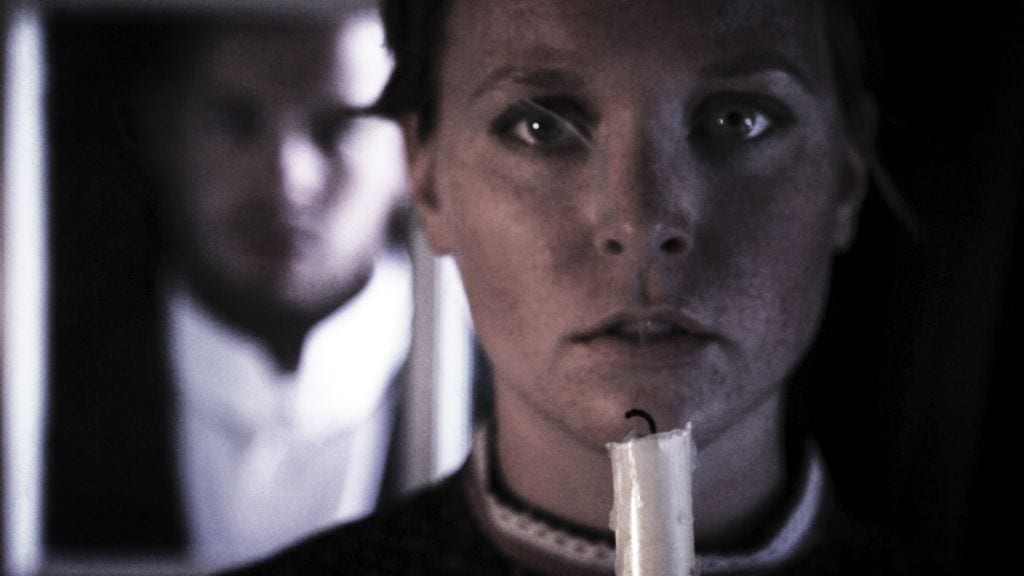PROVO — The last show I saw at the Echo Theatre was The Woman in Black, a production I adored. I went into The Turn of the Screw and Other Ghost Stories with high expectations, and although the show had a bumpy start, by the end I was not disappointed.

Show closes November 16, 2012.
In this review I will attempt to walk they line between critiquing production and giving away vital information that might make the show less interesting to audiences. The Turn of the Screw and Other Ghost Stories is four short ghost stories performed together. “Buried,” written by C. L. Julander, tells the story of Elizabeth, a woman fleeing a seemingly bad relationship, and the men she is running from and towards. “Alone,” written by Jeffrey Lee Blake, shows Michael, who is haunted by the ghost of his daughter. “And She Smiled,” also written by Blake, follows a young student who falls in love with a women he sees from his window, a situation that almost turns deadly. And finally, “Turn of the Screw,” adapted from the Henry James story by Jeffrey Hatcher, is the chilling tale of a governess trying to save her charges from the ghosts of their former caregivers.
The first piece, “Buried,” felt a bit unpolished. This lack of polish had little to do with the acting however. In “Buried” Hailey Nebeker as Elizabeth and David Lassetter as her husband Daniel did a remarkable job. Lassetter in particular was captivating to watch. Before he entered, Elizabeth and Jacob (played by Chris Bentley) planned to run away together, setting Daniel up as a cruel husband and a father who had chosen to reject his own children. When Daniel entered, Bentley portrayed him as condescending and cruel very well. Even when Jacob had a gun pointed at his head, he continued to sneer at his wife, and demand the two of them join him in a guessing game. I hated the man, and found myself wondering why they did not just walk out, as they threatened to do several times. The director, Jeffrey Lee Blake, seemed to have given them no real reason to stay. They were between Daniel and the door with a gun and in that position for a very long time, threatening to leave but staying so the piece could play out. And it played out entirely too quickly. As it became clear that circumstances were not as they appeared and that Daniel was deserving of pity rather than hatred, I felt like I was on a runaway train. There was no time to process the shock of the reveal that turned “Buried” into a ghost story, no moment to realized that everything I had concluded was wrong. Daniel did not reject his children, Elizabeth was not a victim of his violence. Instead, the story barreled through to the end, leaving me feeling like I would never catch up. That moment to realized a twist had occurred, so vital to any ghost story, was missing.
“Alone” had a similar problem. It ended before I could quite get my head around it. While I again found the acting impressive, I was left feeling unsatisfied when it ended. But Joel Applegate gave a good performance as Michael, a man grief stricken over the loss of his daughter. He captured the gruff refusal to talk about his feelings as he refused to let an unnamed lost girl (Melanie Stone Thomason) into his cabin in the woods. When he relented, I saw him change into a man who had regrets about not protecting his daughter and trying to protect this girl who had come into his home.
By the time we got to “And She Smiled” the evening began to improve. I was particularly impressed with the style of the script, written by the director (Blake). It felt like he was trying to mimic the style of 19th century ghost stories, and I felt he succeeded. The tone invoked that time period and reminded me a bit of an Edgar Allan Poe story. This story differed from the others in that I figured out early on what was going on, leaving me hoping against hope that what we knew was going to happen wouldn’t. Most of the story was narrated (by David Lassetter) and so the Woman (Hailey Nebeker) and the Young Man (John Jackson) did most of the performance without speaking or looking at each other. To give the sense that they were living across from each other, both stood on opposite sides of the stage, facing the audience instead of each other. So their interactions, like smiling and waving to each other, were done towards the audience. Both Nebeker and Jackson did well at making it feel as though they were interacting with the other rather than with the audience. As the Young Man became more enthralled, he began to copy the Woman’s movements. She would cut bread, he would cut bread. She would butter it, then he would. The two were very in sync, making it clear that he was not acting entirely of his own volition. And they took time building to the moments of shock, something missing from the first two performances.
The last piece was “Turn of the Screw.” This one was by far the most chilling, and the most interesting. The story has about seven characters, but Blake used a cast of two. Heidi Smith Anderson played the Governess, and Jason Sullivan played nearly everyone else. He started as a narrator that the Governess was telling her tale to, then became the man hiring the Governess to watch his niece and nephew, then became the housekeeper who was looking after the child Flora (who was pantomimed, as she never spoke.) When her brother Miles came home, Sullivan played him as well. I was amazed at how Sullivan physically became each of the characters. As the housekeeper, he hunched over, held his hands in front of him and pitched his voice high. As Miles, he ran about with his arms limp at his sides. While I am unsure why it was decided to cast only two, as there were many talented actors in this piece, I liked it. It reflected the confused and convoluted nature of the story. The build in tension and plot in this piece was wonderful as well. Anderson had to carry much of it on her own, as it was her story. She did a remarkable job seeing things that were not there, as Flora and both ghosts did not make an appearance. But I believed they were there, particularly when Flora takes a boat onto the lake to meet one of the ghosts. The housekeeper goes to rescue her as the Governess stands on the shore. All I knew was what Anderson told us, and she kept the tension and fear of what she was seeing even though she was alone on the stage. As she sees the ghosts of the people who used to care for Flora and Miles, and realizes the evil things they can make the children do, it was unclear who is going to win and even at the end you are left wondering.
The set, designed by Jeffrey Lee Blake, was a large piece that stayed put, and smaller pieces that were brought on for each piece. The set changes killed the mood of the evening, though. They were long and loud and much of what was brought on felt unnecessary. There was extra pieces of furniture that seemed to get in the say rather than add to the ambiance. The set also seemed incompatible with the lights, designed by Matthew Boulter. The main piece had a platform on it, that actors stood on in several pieces. Occasionally, and especially during “Turn of the Screw,” the light hit their bodies rather then their faces, as though they were too high for the lights to hit. And even when the actors stood on the ground, there were many instances where they would walk across the stage and be lit, then not, the lit again. It was distracting and didn’t seem to have anything to do with the plot of the stories. The best technical element was the costumes, designed by Mario Ayala, which established the time periods well and added to the feel of each scene.
Although it started out rough, I ended up enjoying The Turn of the Screw and Other Ghost Stories. The talent of the performers generally made up for any flaws, and by the end I got the feeling I wanted from ghost stories.






